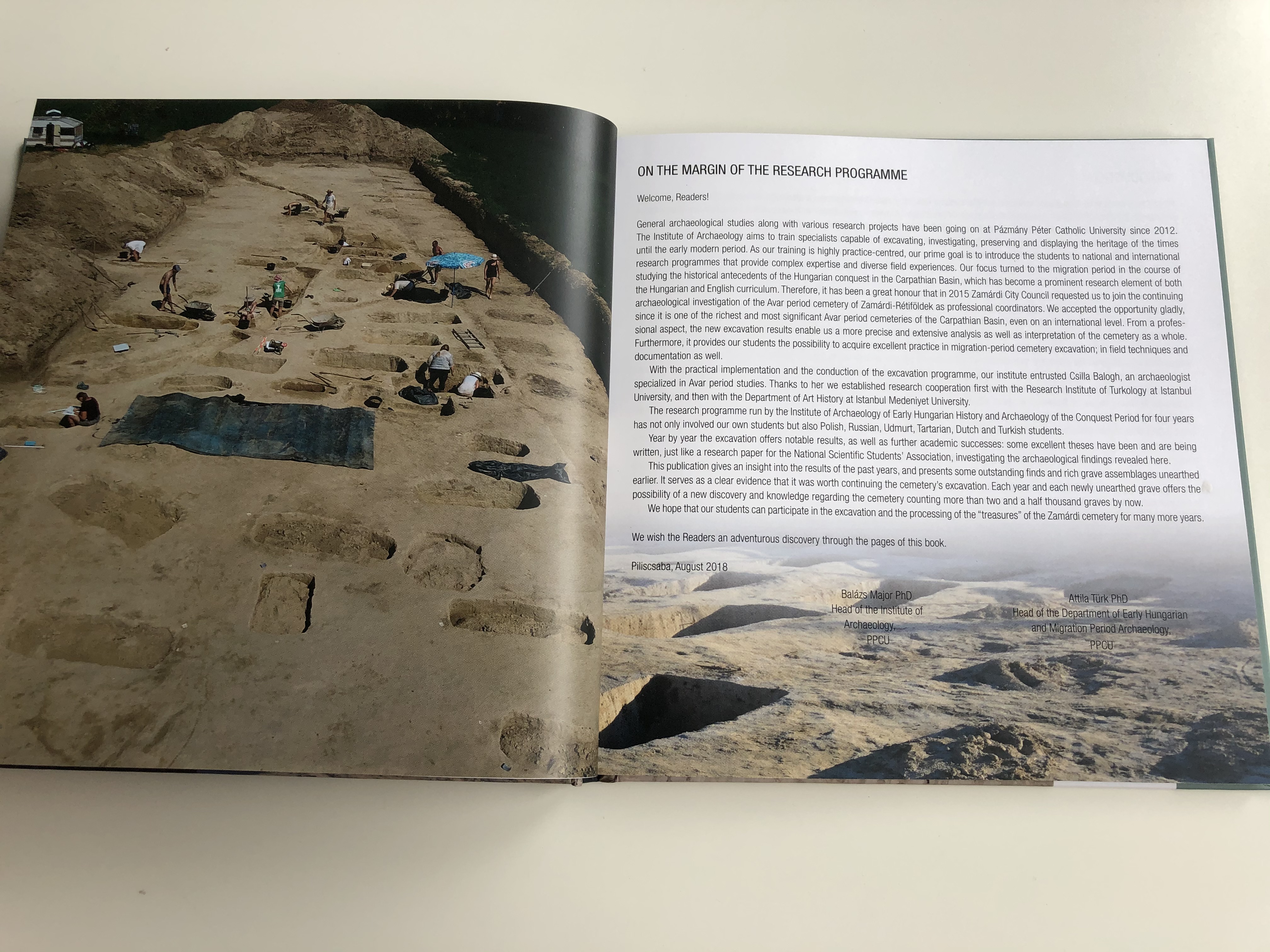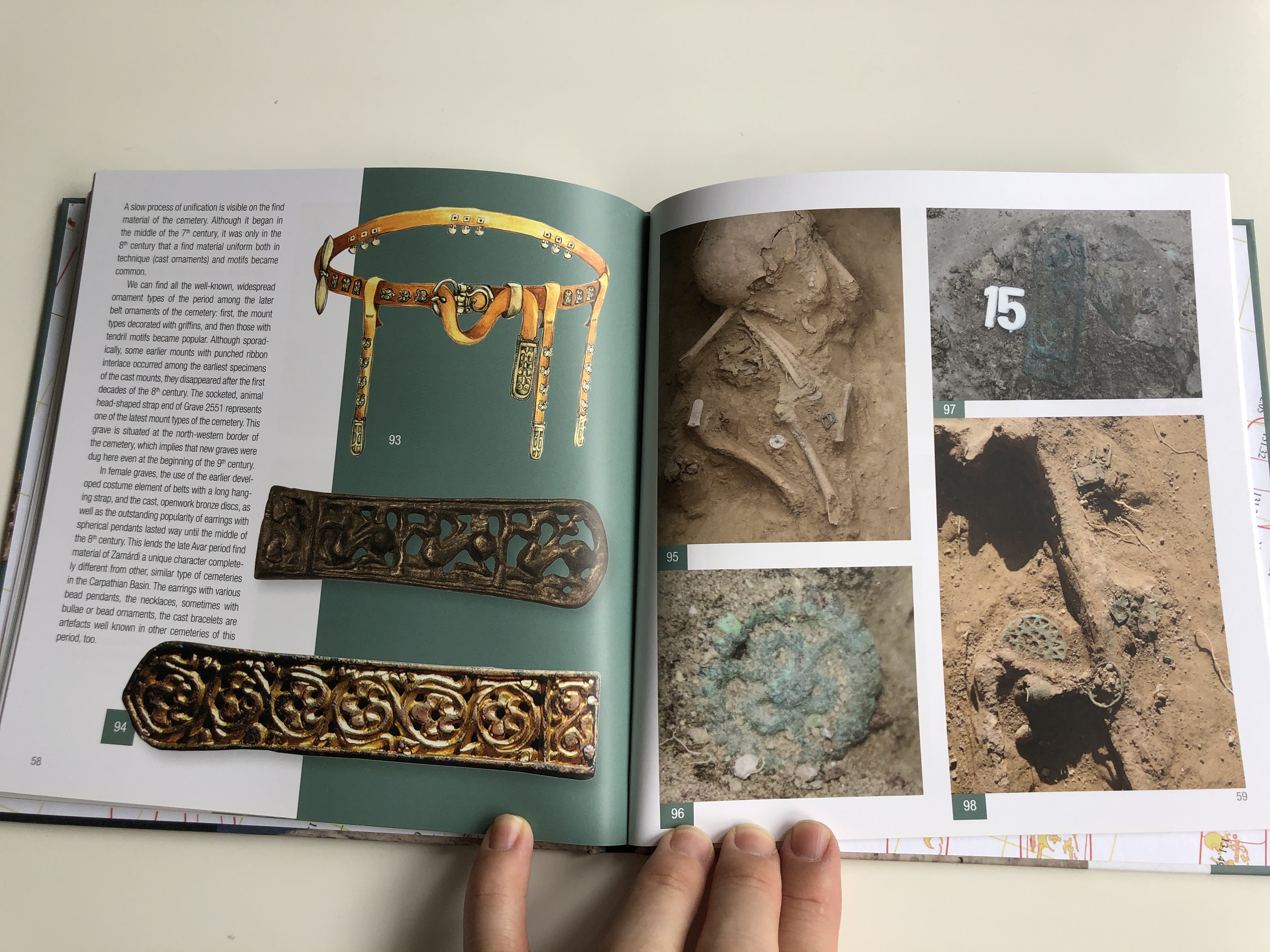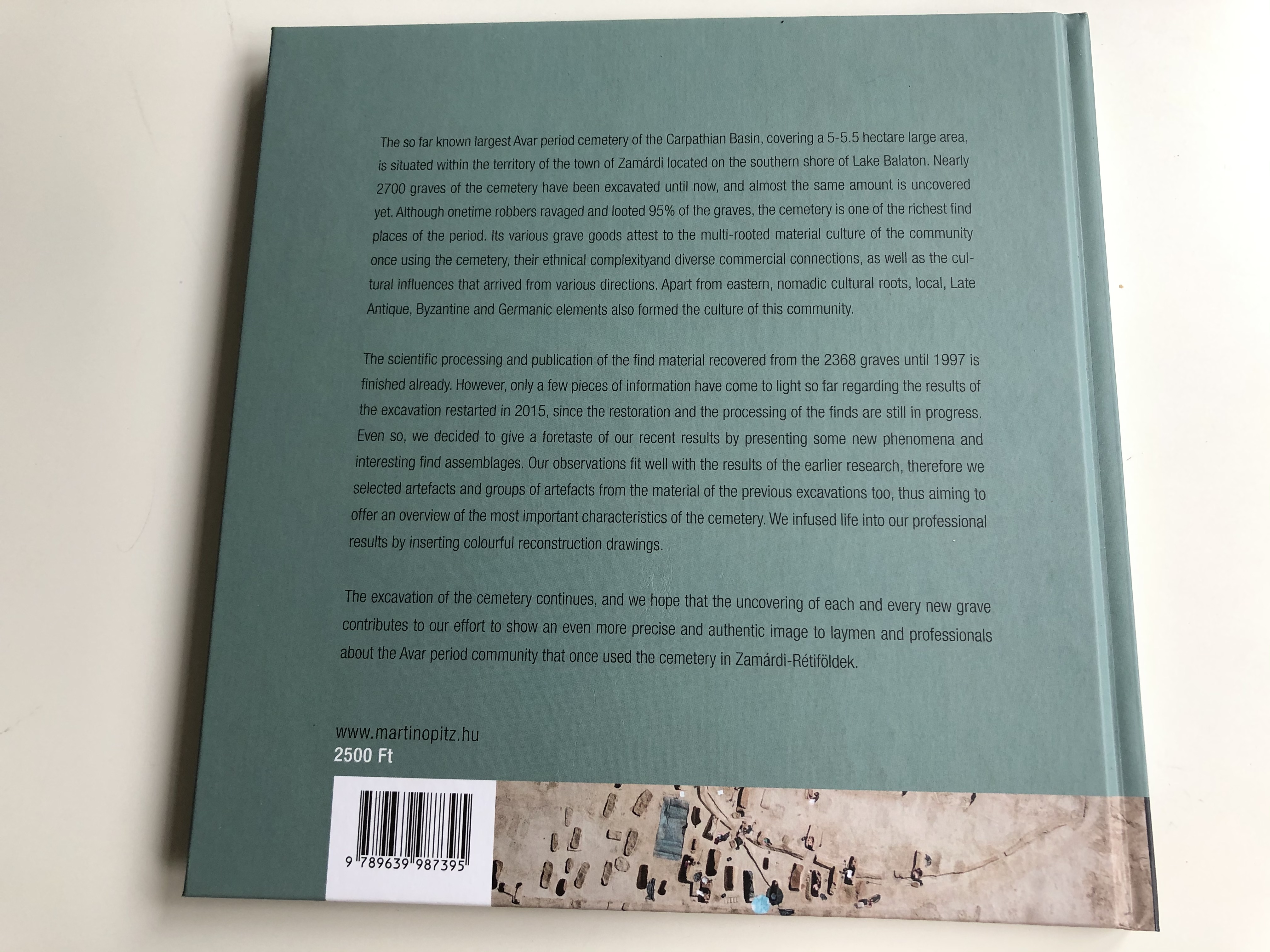"They Vanished away like the Avars" by Csilla Balogh / Avar period cemetery in Zamárdi Rétiföldek / Translated by Zsófia Kondé / Martin Opitz 2019
Hardcover 2019
ISBN: 9789639987395 / 978-9639987395
ISBN-10: 9639987395
PAGES: 72
PUBLISHER: Zamárdi City Council / Martin Opitz
LANGUAGE: ENGLISH / ANGOL
English Translation: Zsófia Kondé
Author: Csilla Balog
English Summary:
Dear Reader,
The Avar period cemetery of Zamárdi is close to my heart: a dedicated teacher, Dezső Piller called the attention of professionals to the existence of the graveyard by the report of my great grandfather, József Csákovics. In 1972, Kornél Bakay unearthed 34 graves. Eight years later, archaeologist Edith Bárdos continued the rescue excavation. Under her leadership, I had the opportunity to work on the excavation myself as a secondary school student for a few weeks. Spending time among students of archaeology gave me lifelong experiences. By the end of the ‘90s, 2368 burials were excavated. The Zamárdi City Council has always supported the exploration of the historical evidences of our land’s former inhabitants, since the treasures hidden underground are the heritage of our ancestors. This, however, only becomes a real treasure if exposed to the general public.
In the past few years, the Institute of Archaeology at Pázmány Péter Catholic University continued the rescue of the well-known Avar period cemetery under archaeologist Csilla Balogh’s direction. With the contribution of enthusiastic university students, approximately 60-70 new graves were unearthed each year, even including intact ones that had not been looted by grave robbers. “Archaeology is fossilized ethnography” – Gyula László believed, and this small volume reveals the past in this spirit. The rich finds yielded by the cemetery located under and around the houses of present-day Rétföldi Street are the tangible evidences of the past; they allow us an insight into the everyday life of our ancestors. The careful burial practices reflect their emotional attachment, and the cohesive force of the onetime community. By means of today’s technique, scientists can gain valuable information and draw exciting conclusions after examining the archaeological findings.
Hungarian Summary:
Az 1997-ig feltárt 2368 sír anyagának tudományos igényű közlése és feldolgozása már elkészült, azonban a 2015-ben újrakezdett ásatás eredményeiről eddig kevés információ látott napvilágot, hiszen a leletanyag restaurálása és feldolgozása még folyamatban van. Ennek ellenére úgy gondoltuk, hogy az eddigi eredményeinkből ízelítőt nyújtunk egy-egy új jelenség, érdekesebb leletegyüttes jellegzetességeinek bemutatásán keresztül. Megfigyeléseink jól illeszkednek a korábbi kutatások eredményeihez, ezért a régebbi ásatás anyagából is emeltünk ki tárgyakat, így törekedve a temető legfontosabb jellegzetességeinek számbavételére. Szakmai mondanivalónkat színes rekonstrukciós rajzokkal "keltettük életre". A temető ásatása tovább folytatódik, és reméljük, hogy minden egyes újabb sír feltárása hozzájárul ahhoz, hogy még pontosabb, hitelesebb képet tárhassunk az érdeklődők és a szakma elé a Rétiföldeken temetkező avar kori közösségről.
The Pannonian Avars (; also known as the Obri in chronicles of Rus, the Abaroi or Varchonitai (Varchonites) or Pseudo-Avars in Byzantine sources) were an alliance of several groups of Eurasian nomads of unknown origins.
They are probably best known for their invasions and destruction in the Avar–Byzantine wars from 568 to 626.
The name Pannonian Avars (after the area in which they eventually settled) is used to distinguish them from the Avars of the Caucasus, a separate people with whom the Pannonian Avars might or might not have had links.
They established the Avar Khaganate, which spanned the Pannonian Basin and considerable areas of Central and Eastern Europe from the late 6th to the early 9th century.
Although the name Avar first appeared in the mid-5th century, the Pannonian Avars entered the historical scene in the mid-6th century,[18] on the Pontic-Caspian steppe as a people who wished to escape the rule of the Göktürks.
ON THE MARGIN OF THE RESEARCH PROGRAMME:
Welcome, Readers!
General archaeological studies along with various research projects have been going on at Pázmány Péter Catholic University since 2012.
The Institute of Archaeology aims to train specialists capable of excavating, investigating, preserving and displaying the heritage of the times
until the early modern period. As our training is highly practice-centred, our prime goal is to introduce the students to national and international
research programmes that provide complex expertise and diverse field experiences. Our focus turned to the migration period in the course of
studying the historical antecedents of the Hungarian conquest in the Carpathian Basin, which has become a prominent research element of both
the Hungarian and English curriculum. Therefore, it has been a great honour that in 2015 Zamárdi City Council requested us to join the continuing
archaeological investigation of the Avar period cemetery of Zamárdi-Rétiföldek as professional coordinators. We accepted the opportunity gladly,
since it is one of the richest and most significant Avar period cemeteries of the Carpathian Basin, even on an international level. From a profes-
sional aspect, the new excavation results enable us a more precise and extensive analysis as well as interpretation of the cemetery as a whole.
Furthermore, it provides our students the possibility to acquire excellent practice in migration-period cemetery excavation; in field techniques and
documentation as well.
With the practical implementation and the conduction of the excavation programme, our institute entrusted Csilla Balogh, an archaeologist
specialized in Avar period studies. Thanks to her we established research cooperation first with the Research Institute of Turkology at Istanbul
University, and then with the Department of Art History at Istanbul Medeniyet University.
The research programme run by the Institute of Archaeology of Early Hungarian History and Archaeology of the Conquest Period for four years
has not only involved our own students but also Polish, Russian, Udmurt, Tartarian, Dutch and Turkish students.
Year by year the excavation offers notable results, as well as further academic successes: some excellent theses have been and are being
written, just like a research paper for the National Scientific Students’ Association, investigating the archaeological findings revealed here.
This publication gives an insight into the results of the past years, and presents some outstanding finds and rich grave assemblages unearthed
earlier. It serves as a clear evidence that it was worth continuing the cemetery’s excavation. Each year and each newly unearthed grave offers the
possibility of a new discovery and knowledge regarding the cemetery counting more than two and a half thousand graves by now.
We hope that our students can participate in the excavation and the processing of the “treasures” of the Zamárdi cemetery for many more years.
We wish the Readers an adventurous discovery through the pages of this book.
Piliscsaba, August 2018
INTRODUCTION
In 2015, the Institute of Archaeology of Pázmány Péter Catholic University asked me to join the archaeological investigation of the Avar period
cemetery of Zamárdi-Rétiföldek – restarting after a pause of more than 15 years – as conductor of the excavation. Hungarian and international
research had long known a number of prime finds of the Zamárdi cemetery from various exhibition catalogues, just like the material of the 2368
graves uncovered until 1998 and published by Edith Bárdos and Éva Garam in Volumes 9 and 10 of Monumenta Avarorum Archaeologica (2009,
2014). Unfortunately, the analysis of the finds had to be put on hold then. Even so, for those who studied this period, the ethnical and cultural
diversity of the community using the cemetery, as well as the outstanding significance of this site among the nearly three and a half thousand
Avar period burial places of the Carpathian Basin was obvious.
The opinion of Hungarian researchers varied on whether it was worth and necessary to continue the excavation of the cemetery, in which they
had already known more graves than in other large cemeteries. I, personally, had no doubt about the continuation of the cemetery excavation,
and the inherent opportunities and professional outcomes. We knew by the evidence of the narrow research trench opened north and south of
the cemetery section uncovered by Edith Bárdos, aiming to detect its extension, that besides the 2368 burials excavated until 1998 the cemetery
probably contained nearly the same amount of graves yet. Moreover, the discovery of every new grave is a step further towards a more detailed
and precise knowledge on the graveyard as a whole.
In addition to professional aspects and interests in a narrow sense, another apropos of this research excavation was to provide practice field
for students of archaeology for acquiring methods of Migration period cemetery excavations. I believe the past four seasons of excavation were
successful in several respects. Dozens of students have participated, acquired skills in excavating graves, and learned the various phases of
recording. Furthermore, the interest of some students who became acquainted with the Migration period in Zamárdi turned towards the research
of the Avar period, resulting in university theses and a research paper for the National Scientific Students’ Association.
Year by year, the interest of people from the neighbourhood is growing towards the results of the excavation, and a number of new phenomena
have come to light that might even be a novelty for professionals. Therefore, we decided to publish the first results by presenting the most inter-
esting observations, details, and new phenomena, even though the restoration and scientific processing of the material of the 332 features having
been revealed on a nearly 3000 m2 area from 2008 are still in progress. In most cases, these results supplement Éva Garam’s analyses written
on the material of former excavations, and published meanwhile in Volume 12 of Monumenta Avarorum Archaeologica (2018).
Our goal is therefore a preliminary report; however, as our research is an organic continuation of the earlier, nearly two decades of excava-
tions, and our results complete the results of those, we thought that our publication would be kind of a torso without presenting the earlier finds.
This is the reason why we decided to create a small volume that aims to provide an insight into the cemetery as a whole, by presenting some
exciting burial practices, special finds and find assemblages, while touching upon both previously and newly unearthed materials. Obviously, it is
not possible to provide an overall, comprehensive view of the cemetery within the framework of this booklet. We have thus sought an approach
that reveals the few artefacts and phenomena selected from the culturally complex, abundant material of the cemetery in a way that brings people
once living here to life. Beside the field photographs and pictures of the finds, we present reconstructions of the original artefacts and costumes
that “narrate” the onetime way of use of the archaeological finds and clothing elements in pictures. Fruzsina Pápai, former student of the Institute
of Archaeology at Pázmány Péter Catholic University shaped the reconstructions striving for professional authenticity into artistic illustrations; she
formed the information revealed by scientific methods into scenes, movements, and feelings between the characters.
I hope that if citizens of Zamárdi leaf through the pages of this book, they will be even prouder of their city, and that nearby residents and
“wanderers” arriving from afar will be even more interested in this little town on the shore of Lake Balaton. I also hope that it will convince sceptical
archaeologists that it is indeed worth continuing to research the cemetery, as each and every grave includes the possibility of a new discovery.
Special thanks go to mayor Gyula Csákovics who helped turning our friendly conversation into a decision, and created the necessary financial
conditions. We also owe thanks to the City Council of Zamárdi for funding the excavation year after year. In the last years, many of our colleagues
participated in the project for a longer or shorter period: archaeologists Tamás Czuppon, Bence Gulyás and Géza Szabó, anthropologists Antónia
Marcsik, Erika Molnár and Olga Spekker, and archaeozoologist Éva Ágnes Nyerges. I am indebted to them for their selfless assistance. From 2015,
the archaeological objects – often in very poor condition – have been in great care in the hands of Bernadett Dobó, Márta Borbíró and Teréz
Vidovics, who reveal their beauty from under the thick corrosion or dried layer of dirt, and restore their original glow. Here, again, I would like to
express my gratitude for their careful work. Our research is not a one-person success but the hard and persistent work of many students. I hope
that they will take part in this “adventure” for many more years.
Zamárdi, August 2018































































